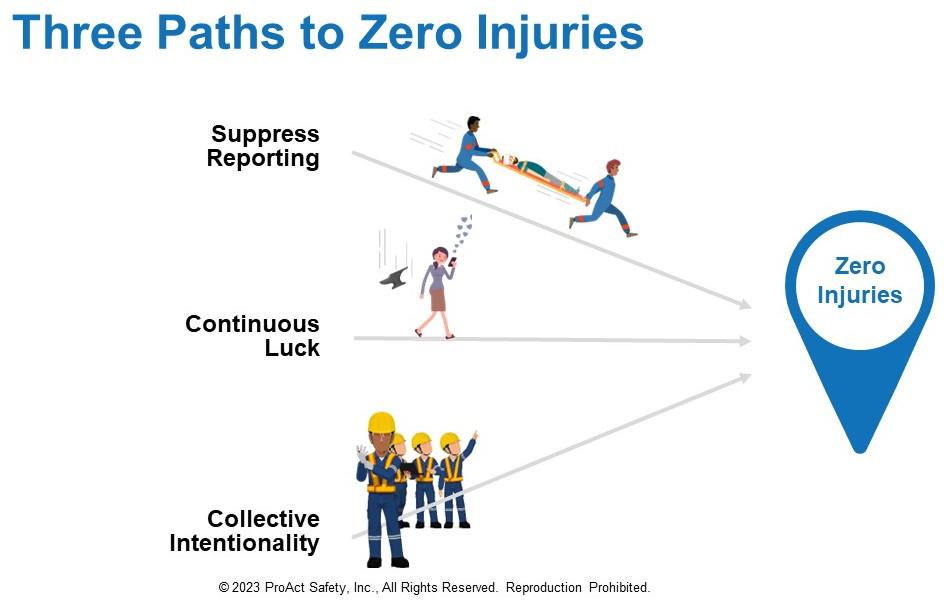BIC - June 2023
By: Shawn M. Galloway
Printable Version
How do you target nothingness? Skilled in marksmanship, I've always struggled with that one. When the goal of safety is primarily defined as, or measured by, zero accidents, success becomes internalized as, "Anything I do that does not produce an outcome is safe." This is flawed logic due to a flawed approach to safety excellence. Many companies have evolved past the originally well-intended mindset and goal of targeting zero. They instead focus their company on the path of making safety excellence happen moment by moment, minute by minute.
One common aspect among the most successful corporations dedicated to pursuing safety excellence is that while they of course never want an injury or incident to occur, they no longer focus on injury rates nor promote or measure progress toward a goal or target of zero injuries. Why? Because experience yields the unintended consequences of holding people accountable for injury rates. Even the best intending group of leaders can inadvertently create an environment where the workforce feels leadership cares more about the numbers than the people. Be careful of what you measure; people work towards the measurements.
After more than two decades of working inside and with all major industries, regardless of country or type of business, there are three paths a company can take that will yield zero injuries.

Suppress Reporting — This is unethical and, in many countries, illegal. Despite this, many examples exist across every industry of individuals choosing not to report due to the many pressures — self-imposed, peers, leadership, etc. — that come with working towards that target. To navigate off this path, work to create a psychologically safe culture where it becomes strange to not talk about deviations from expectations, minor or significant. Normalize conversations about mistakes and things not going according to plan that focus on the what and the why, not the who. Make discipline a tool of last resort.
Continuous Luck — Some people accidentally have a day without an injury. When a day ends or a month or year passes without an injury, and leadership cannot confidentially and precisely pinpoint how this happened, too much luck is involved. Luck alone is a terrible strategy. To get off this path, work to manage luck out of the equation. Focus on ensuring engaging pre- and post-job discussions, leadership presence on the floor or in the field, prompting conversations with workers and between workers to identify what is going well and when deviations are occurring and discussing or identifying negative influences on behaviors that need to be addressed.
Collective Intentionality — Be intentional with every task, minute by minute. To stay on this path, equip your people to be successful with the proper knowledge, mindsets, competencies and reinforcement systems. Realize that mistakes are usual in complex environments. Ensure robust recovery systems are in place to minimize the impact from a deviation or bring the person, equipment or environment back to the pre-deviation state. This is the path that great organizations continue on, since they realize that there will always be a better way, regardless of good current performance. This path proceeds past zero injuries because we cannot eliminate all hazards and risks; humans are fallible, and how we define success will continue to evolve. What path are you on?

Shawn M. Galloway is the CEO of ProAct Safety and an advisor to leading organizations across all major industries. With over twenty years of experience in safety systems, strategy, culture, leadership, and employee engagement, he is a trusted advisor, keynote speaker, and expert witness.
He is the author of several bestselling books and has multiple regular columns in leading magazines, with over 400 articles and 100 videos to his credit. He also created the first safety podcast, Safety Culture Excellence, with over 800 episodes. Shawn has received numerous prestigious accolades and has been featured in Power 101 Leaders of the EHS World, Top 50 People Who Most Influenced EHS, Top 40 Rising Stars, Top 11 Health and Safety Influencers, and Top 10 Speakers.
He serves on the Harvard Business Review Advisory Council and the Fast Company Executive Board. He has appeared as a guest on Bloomberg, Fox News, The Daily Mail, Dubai One, U.S. News & World Report, Sirius Business Radio, Wharton Business Daily, and leading safety magazines and podcasts, reinforcing his status as an authority in the field of safety excellence.
For more information, call +1.936.273.8700 or email info@ProActSafety.com.
